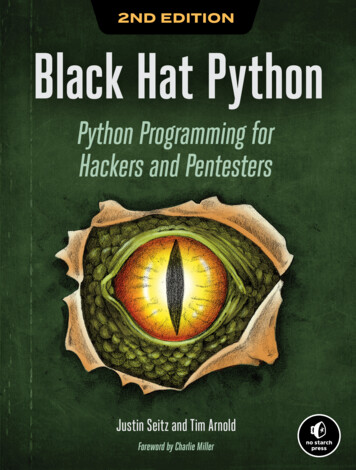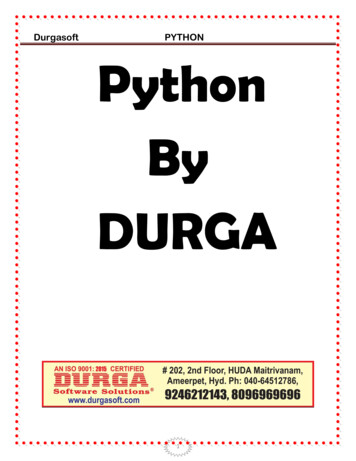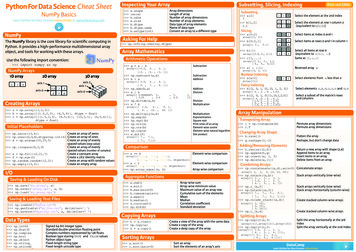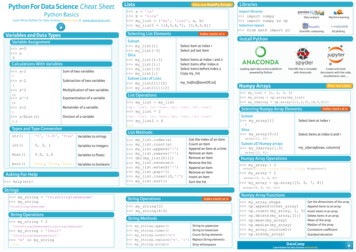
Transcription
.me/aedahamlibrary
https://telegram.me/aedahamlibraryLearn Python in One Day and Learn It WellPython for Beginners with Hands-on ProjectThe only book you need to start coding in Pythonimmediately(Second Edition)By Jamie Chanhttp://www.learncodingfast.com/pythonCopyright 2014; 2017All rights reserved. No part of this publication may be reproduced,distributed, or transmitted in any form or by any means, includingphotocopying, recording, or other electronic or mechanical methods, withoutthe prior written permission of the publisher, except in the case of briefquotations embodied in critical reviews and certain other noncommercial usespermitted by copyright law.PrefaceThis book is written to help you learn Python programming FAST and learnit WELL. If you are an absolute beginner in Programming, you'll find thatthis book explains complex concepts in an easy to understand manner. If youare an experienced coder, this book gives you a good base from which toexplore Python.Topics are carefully selected to give you a broad exposure to Python, whilenot overwhelming you with information overload. These topics includecontrol structures, error handling techniques, file handling techniques andmore. New chapters on object-oriented programming are also included in thisedition.
https://telegram.me/aedahamlibraryExamples are carefully chosen to demonstrate each concept so that you cangain a deeper understand of the language. The appendices at the end of thebook will also provide you with a convenient reference for some of thecommonly used functions in Python.In addition, as Richard Branson puts it: "The best way of learning aboutanything is by doing". At the end of the course, you'll be guided through aproject that gives you a chance to put what you've learned to use.You can download the source code for the project and the appendices athttp://www.learncodingfast.com/pythonAny errata can be found athttp://www.learncodingfast.com/errataContact InformationI would love to hear from you.For feedback or queries, you can contact me atjamie@learncodingfast.com.More Books by Jamie
https://telegram.me/aedahamlibraryC#: Learn C# in One Day and Learn It WellJava: Learn Java in One Day and Learn It WellCSS: Learn CSS in One Day and Learn It Well
https://telegram.me/aedahamlibraryTable of ContentsChapter 1: Python, what Python?1.1 What is Python?1.2 Why Learn Python?Chapter 2: Getting ready for Python2.1 Installing the Interpreter2.2 Using the Python Shell, IDLE and Writing our FIRST programChapter 3: The World of Variables and Operators3.1 What are variables?3.2 Naming a Variable3.3 The Assignment Operator3.4 Basic Operators3.5 More Assignment OperatorsChapter 4: Data Types in Python4.1 Integers4.2 Float4.3 String4.4 Type Casting In Python4.5 List4.6 Tuple4.7 DictionaryChapter 5: Making Your Program Interactive5.1 input()5.2 print()5.3 Triple Quotes5.4 Escape CharactersChapter 6: Making Choices and Decisions6.1 Condition Statements6.2 If Statement6.3 Inline If6.4 For Loop6.5 While Loop6.6 Break
https://telegram.me/aedahamlibrary6.7 Continue6.8 Try, ExceptChapter 7: Functions and Modules7.1 What are Functions?7.2 Defining Your Own Functions7.3 Variable Scope7.4 Default Parameter Values7.5 Variable Length Argument List7.6 Importing Modules7.7 Creating our Own ModuleChapter 8: Working with Files8.1 Opening and Reading Text Files8.2 Using a For Loop to Read Text Files8.3 Writing to a Text File8.4 Opening and Reading Text Files by Buffer Size8.5 Opening, Reading and Writing Binary Files8.6 Deleting and Renaming FilesChapter 9: Object Oriented Programming Part 19.1 What is Object-Oriented Programming?9.2 Writing our own class9.3 Instantiating an Object9.4 Properties9.5 Name Mangling9.6 What is self9.7 Class and Static Methods9.8 Importing a classChapter 10: Object Oriented Programming Part 210.1 Inheritance10.2 Writing the Child Class10.3 Instantiating a Child Object10.4 Python Special Methods10.5 Python Built-in Functions for ObjectsProject: Math and BinaryPart 1: gametasks.py
https://telegram.me/aedahamlibraryPart 2: gameclasses.pyPart 3: project.pyThank YouAppendix A: Working With StringsAppendix B: Working With ListsAppendix C: Working With TuplesAppendix D: Working With DictionariesAppendix E: Project AnswersOne Last Thing
https://telegram.me/aedahamlibraryChapter 1: Python, what Python?Welcome to the exciting world of programming. I'm so glad you picked upthis book and I sincerely hope this book can help you master the Pythonlanguage and experience the exhilaration of programming. Before we diveinto the nuts and bolts of Python programming, let us first answer a fewquestions.1.1 What is Python?Python is a widely used high-level programming language created by Guidovan Rossum in the late 1980s. The language places strong emphasis on codereadability and simplicity, making it possible for programmers to developapplications rapidly.Like all high level programming languages, Python code resembles theEnglish language which computers are unable to understand. Codes that wewrite in Python have to be interpreted by a special program known as thePython interpreter, which we’ll have to install before we can code, test andexecute our Python programs. We'll look at how to install the Pythoninterpreter in Chapter 2.There are also a number of third-party tools, such as Py2exe or Pyinstallerthat allow us to package our Python code into stand-alone executableprograms for some of the most popular operating systems like Windows andMac OS. This allows us to distribute our Python programs without requiringthe users to install the Python interpreter.1.2 Why Learn Python?There are a large number of high level programming languages available,such as C, C , and Java. The good news is all high level programminglanguages are very similar to one another. What differs is mainly the syntax,the libraries available and the way we access those libraries. A library issimply a collection of resources and pre-written codes that we can use when
https://telegram.me/aedahamlibrarywe write our programs. If you learn one language well, you can easily learn anew language in a fraction of the time it took you to learn the first language.If you are new to programming, Python is a great place to start. One of thekey features of Python is its simplicity, making it the ideal language forbeginners to learn. Most programs in Python require considerably fewer linesof code to perform the same task compared to other languages such as C.This leads to fewer programming errors and reduces the development timeneeded. In addition, Python comes with an extensive collection of third partyresources that extend the capabilities of the language. As such, Python can beused for a large variety of tasks, such as for desktop applications, databaseapplications, network programming, game programming and even mobiledevelopment. Last but not least, Python is a cross platform language, whichmeans that code written for one operating system, such as Windows, willwork well on Mac OS or Linux without making any changes to the Pythoncode.Convinced that Python is THE language to learn? Let’s get started.
https://telegram.me/aedahamlibraryChapter 2: Getting ready for Python2.1 Installing the InterpreterBefore we can write our first Python program, we have to download theappropriate interpreter for our computers.We’ll be using Python 3 in this book because as stated on the official Pythonsite “Python 2.x is legacy, Python 3.x is the present and future of thelanguage”. In addition, “Python 3 eliminates many quirks that canunnecessarily trip up beginning programmers”.However, note that Python 2 is currently still rather widely used. Python 2and 3 are about 90% similar. Hence if you learn Python 3, you will likelyhave no problems understanding codes written in Python 2.To install the interpreter for Python 3, head over tohttps://www.python.org/downloads/. The correct version should be indicatedat the top of the webpage. We’ll be using version 3.6.1 in this book. Click on“Download Python 3.6.1” and the software will start downloading.Alternatively if you want to install a different version, scroll down the pageand you’ll see a listing of other versions. Click on the release version that youwant. You’ll be redirected to the download page for that version.Scroll down towards the end of the page and you’ll see a table listing variousinstallers for that version. Choose the correct installer for your computer. Theinstaller to use depends on two factors:
https://telegram.me/aedahamlibrary1. The operating system (Windows, Mac OS, or Linux) and2. The processor (32-bit vs 64-bit) that you are using.For instance, if you are using a 64-bit Windows computer, you will likely beusing the "Windows x86-64 executable installer". Just click on the link todownload it. If you download and run the wrong installer, no worries. Youwill get an error message and the interpreter will not install. Simplydownload the correct installer and you are good to go.Once you have successfully installed the interpreter, you are ready to startcoding in Python.2.2 Using the Python Shell, IDLE and Writing our FIRSTprogramWe’ll be writing our code using the IDLE program that comes bundled withour Python interpreter.To do that, let’s first launch the IDLE program. You launch the IDLEprogram like how you launch any other programs. For instance on Windows10, you can search for it by typing “IDLE” in the search box. Once it isfound, click on IDLE (Python GUI) to launch it. You’ll be presented with thePython Shell shown below.The Python Shell allows us to use Python in interactive mode. This means wecan enter one command at a time. The Shell waits for a command from theuser, executes it and returns the result of the execution. After this, the Shellwaits for the next command.
https://telegram.me/aedahamlibraryTry typing the following into the Shell. The lines starting with are thecommands you should type while the lines after the commands show theresults. 2 35 3 2True print ('Hello World')Hello WorldWhen you type 2 3, you are issuing a command to the Shell, asking it toevaluate the value of 2 3. Hence, the Shell returns the answer 5. When youtype 3 2, you are asking the Shell if 3 is greater than 2. The Shell repliesTrue. Next, print is a command asking the Shell to display the line HelloWorld.The Python Shell is a very convenient tool for testing Python commands,especially when we are first getting started with the language. However, ifyou exit from the Python Shell and enter it again, all the commands you typewill be gone. In addition, you cannot use the Python Shell to create an actualprogram. To code an actual program, you need to write your code in a textfile and save it with a .py extension. This file is known as a Python script.To create a Python script, click on File New File in the top menu of ourPython Shell. This will bring up the text editor that we are going to use towrite our very first program, the “Hello World” program. Writing the “HelloWorld” program is kind of like the rite of passage for all new programmers.We’ll be using this program to familiarize ourselves with the IDLE software.Type the following code into the text editor (not the Shell).#Prints the Words "Hello World"print ("Hello World")You should notice that the line #Prints the Words "Hello World" is in redwhile the word print is in purple and "Hello World" is in green. This is the
https://telegram.me/aedahamlibrarysoftware’s way of making our code easier to read. The words print and"Hello World" serve different purposes in our program, hence they aredisplayed using different colors. We’ll go into more details in later chapters.The line #Prints the Words "Hello World" (in red) is actually not part ofthe program. It is a comment written to make our code more readable forother programmers. This line is ignored by the Python interpreter. To addcomments to our program, we type a # sign in front of each line of comment,like this:#This is a comment#This is also a comment#This is yet another commentAlternatively, we can also use three single quotes (or three double quotes) formultiline comments, like this:'''This is a commentThis is also a commentThis is yet another comment'''Now click File Save As to save your code. Make sure you save it withthe .py extension.Done? Voilà! You have just successfully written your first Python program.Finally click on Run Run Module to execute the program (or press F5).You should see the words Hello World printed on your Python Shell.
https://telegram.me/aedahamlibraryChapter 3: The World of Variables and OperatorsNow that we’re done with the introductory stuff, let’s get down to the realstuff. In this chapter, you’ll learn all about variables and operators.Specifically, you’ll learn what variables are and how to name and declarethem. We’ll also learn about the common operations that we can perform onthem. Ready? Let’s go.3.1 What are variables?Variables are names given to data that we need to store and manipulate in ourprograms. For instance, suppose your program needs to store the age of auser. To do that, we can name this data userAge and define the variableuserAge using the following statement.userAge 0After you define the variable userAge, your program will allocate a certainarea of your computer's storage space to store this data. You can then accessand modify this data by referring to it by its name, userAge. Every time youdeclare a new variable, you need to give it an initial value. In this example,we gave it the value 0. We can always change this value in our program later.We can also define multiple variables at one go. To do that simply writeuserAge, userName 30, 'Peter'This is equivalent touserAge 30userName 'Peter'3.2 Naming a VariableA variable name in Python can only contain letters (a - z, A - B), numbers or
https://telegram.me/aedahamlibraryunderscores ( ). However, the first character cannot be a number. Hence, youcan name your variables userName, user name or userName2 but not2userName.In addition, there are some reserved words that you cannot use as a variablename because they already have preassigned meanings in Python. Thesereserved words include words like print, input, if, while etc. We’ll learnabout each of them in subsequent chapters.Finally, variable names are case sensitive. username is not the same asuserName.There are two conventions when naming a variable in Python. We can eitheruse the camel case notation or use underscores. Camel case is the practice ofwriting compound words with mixed casing (e.g. thisIsAVariableName).This is the convention that we’ll be using in the rest of the book.Alternatively, another common practice is to use underscores ( ) to separatethe words. If you prefer, you can name your variables like this:this is a variable name.3.3 The Assignment OperatorNote that the sign in the statement userAge 0 has a different meaningfrom the sign we learned in Math. In programming, the sign is known asan assignment operator. It means we are assigning the value on the right sideof the sign to the variable on the left. A good way to understand thestatement userAge 0 is to think of it as userAge - 0.The statements x y and y x have very different meanings inprogramming.Confused? An example will likely clear this up.Type the following code into your IDLE editor and save it.
https://telegram.me/aedahamlibraryx 5y 10x yprint ("x ", x)print ("y ", y)Now run the program. You should get this output:x 10y 10Although x has an initial value of 5 (declared on the first line), the third line x y assigns the value of y to x (think of it as x - y), hence changing thevalue of x to 10 while the value of y remains unchanged.Next, modify the program by changing ONLY ONE statement: Change thethird line from x y to y x. Mathematically, x y and y x mean thesame thing. However, this is not so in programming.Run the second program. You will now getx 5y 5You can see that in this example, the x value remains as 5, but the value of yis changed to 5. This is because the statement y x assigns the value of x toy.ybecomes 5 while x remains unchanged as 5.3.4 Basic OperatorsBesides assigning a variable an initial value, we can also perform the usualmathematical operations on variables. Basic operators in Python include , -,*, /, //, % and ** which represent addition, subtraction, multiplication,division, floor division, modulus and exponent respectively.
https://telegram.me/aedahamlibraryExample:Suppose x 5, y 2Addition:x y 7Subtraction:x - y 3Multiplication:x*y 10Division:x/y 2.5Floor Division:x//y 2 (rounds down the answer to the nearest whole number)Modulus:x%y 1 (gives the remainder when 5 is divided by 2)Exponent:x**y 25(5 to the power of 2)3.5 More Assignment OperatorsBesides the operator, there are a few more assignment operators in Python(and most programming languages). These include operators like , - and* .Suppose we have the variable x, with an initial value of 10. If we want toincrement x by 2, we can writex x 2
https://telegram.me/aedahamlibraryThe program will first evaluate the expression on the right (x 2) and assignthe answer to the left. So eventually the statement above becomes x 12.Instead of writing x x 2, we can also write x 2 to express the samemeaning. The sign is actually a shorthand that combines the assignmentsign with the addition operator. Hence, x 2 simply means x x 2.Similarly, if we want to do a subtraction, we can write x x - 2 or x - 2.The same works for all the 7 operators mentioned in the section above.
https://telegram.me/aedahamlibraryChapter 4: Data Types in PythonNow, let us move on to look at data types in Python. Data type simply refersto the type of data that a variable stores.We’ll first look at some basic data types in Python, specifically the integer,float and string. Next, we’ll explore the concept of type casting. Finally, we’lldiscuss three more advanced data types in Python: the list, tuple anddictionary.4.1 IntegersIntegers are numbers with no decimal parts, such as -5, -4, -3, 0, 5, 7 etc.To declare an integer in Python, simply write variableName initialvalueExample:userAge 20mobileNumber 123987244.2 FloatFloat refers to numbers that have decimal parts, such as 1.234, -0.023, 12.01.To declare a float in Python, we write variableName initial valueExample:userHeight 1.82userWeight 67.24.3 StringString refers to text.
https://telegram.me/aedahamlibraryTo declare a string, you can either use variableName 'initial value'(single quotes) or variableName "initial value" (double quotes)Example:userName 'Peter'userSpouseName "Janet"userAge '30'In the last example, because we wrote userAge '30', userAge is a string.In contrast, if you wrote userAge 30 (without quotes), userAge is aninteger.We can combine multiple substrings by using the concatenate sign ( ). Forinstance, "Peter " "Lee" is equivalent to the string "Peter Lee".Built-In String FunctionsPython includes a number of built-in functions to manipulate strings. Afunction is a block of reusable code that performs a certain task. We’lldiscuss functions in greater depth in Chapter 7.An example of a function available in Python is the upper() method forstrings. You use it to capitalize all the letters in a string. For instance,'Peter'.upper() will give us the string 'PETER'. You can refer to AppendixA for more examples and sample codes on how to use Python’s built-in stringmethods.Formatting Strings using the % OperatorStrings can also be formatted using the % operator. This gives you greatercontrol over how you want your string to be displayed and stored. The syntaxfor using the % operator is"string to be formatted" %(values or variables to be insertedinto string, separated by commas)
https://telegram.me/aedahamlibraryThere are three parts to this syntax. First we write the string to be formattedin quotes. Next we write the % symbol. Finally, we have a pair of parentheses( ) within which we write the values or variables to be inserted into the string.This parentheses with values inside is actually known as a tuple, a data typethat we’ll cover later in this chapter.Type the following code in IDLE and run it.brand 'Apple'exchangeRate 1.235235245message 'The price of this %s laptop is %d USD and the exchangerate is %4.2f USD to 1 EUR' %(brand, 1299, exchangeRate)print (message)In the example above, the string 'The price of this %s laptop is %dUSD and the exchange rate is %4.2f USD to 1 EUR' is the string that wewant to format.%s, %dand %4.2f are known as formatters; they serve as placeholders in thestring.These placeholders will be replaced with the variable brand, the value 1299and the variable exchangeRate respectively, as indicated in the parentheses.If we run the code, we’ll get the output below.The price of this Apple laptop is 1299 USD and the exchange rateis 1.24 USD to 1 EURThe %s formatter is used to represent a string ('Apple' in this case) while the%d formatter represents an integer (1299). If we want to add spaces before aninteger, we can add a number between % and d to indicate the desired lengthof the string. For instance "%5d" %(123) will give us " 123" (with 2 spacesin front and a total length of 5).
https://telegram.me/aedahamlibraryThe %f formatter is used to format floats (numbers with decimals). Here weformat it as %4.2f where 4 refers to the total length and 2 refers to 2 decimalplaces. If we want to add spaces before the number, we can format is as%7.2f, which will give us "1.24" (with 2 decimal places, 3 spaces in frontand a total length of 7).Formatting Strings using the format() methodIn addition to using the % operator to format strings, Python also provides uswith the format() method to format strings. The syntax is"string to be formatted".format(values or variables to beinserted into string, separated by commas)When we use the format() method, we do not use %s, %f or %d asplaceholders. Instead we use braces { }, like this:message 'The price of this {0:s} laptop is {1:d} USD and theexchange rate is {2:4.2f} USD to 1 EUR'.format('Apple', 1299,1.235235245)Inside the braces, we first write the position of the argument to use, followedby a colon. After the colon, we write the formatter. There should not be anyspaces within the braces.When we write format('Apple', 1299, 1.235235245), we are passing inthree arguments to the format() method. Arguments are data that the methodneeds in order to perform its task. The arguments are 'Apple', 1299 and1.235235245.The argument 'Apple' has a position of 0,1299 has a position of 1 and1.235235245 has a position of2.Positions always start from ZERO.
https://telegram.me/aedahamlibraryWhen we write {0:s}, we are asking the interpreter to replace {0:s} with theargument in position 0 and that it is a string (because the formatter is s).When we write {1:d}, we are referring to the argument in position 1, whichis an integer (formatter is d).When we write {2:4.2f}, we are referring to the argument in position 2,which is a float and we want it to be formatted with 2 decimal places and atotal length of 4 (formatter is 4.2f).If we print message, we’ll getThe price of this Apple laptop is 1299 USD and the exchange rateis 1.24 USD to 1 EURNote: If you do not want to format the string, you can simply writemessage 'The price of this {} laptop is {} USD and the exchangerate is {} USD to 1 EUR'.format('Apple', 1299, 1.235235245)Here we do not have to specify the position of the arguments. The interpreterwill replace the braces based on the order of the arguments provided. We’llgetThe price of this Apple laptop is 1299 USD and the exchange rateis 1.235235245 USD to 1 EURThe format() method can be kind of confusing to beginners. In fact, stringformatting can be more fanciful than what we’ve covered here, but whatwe’ve covered is sufficient for most purposes. To get a better understandingof the format() method, try the following program.message1message2message3message4 '{0} is easier than {1}'.format('Python', 'Java')'{1} is easier than {0}'.format('Python', 'Java')'{:10.2f} and {:d}'.format(1.234234234, 12)'{}'.format(1.234234234)print (message1)#You’ll get 'Python is easier than Java'
https://telegram.me/aedahamlibraryprint (message2)#You’ll get 'Java is easier than Python'print (message3)#You’ll get '1.23 and 12'#You do not need to indicate the positions of the arguments.print (message4)#You’ll get '1.234234234'. No formatting is done.You can use the Python Shell to experiment with the format() method. Trytyping in various strings and see what you get.4.4 Type Casting In PythonSometimes in our program, it is necessary for us to convert from one datatype to another, such as from an integer to a string. This is known as typecasting.There are three built-in functions in Python that allow us to do type casting.These are the int(), float(), and str() functions.The int() function in Python takes in a float or an appropriate string andconverts it to an integer. To change a float to an integer, we can typeint(5.712987). We’ll get 5 as the result (anything after the decimal point isremoved). To change a string to an integer, we can type int("4") and we’llget 4. However, we cannot type int("Hello") or int("4.22321"). We’ll getan error in both cases.The float() function takes in an integer or an appropriate string and changesit to a float. For instance, if we type float(2) or float("2"), we’ll get 2.0. Ifwe type float("2.09109"), we’ll get 2.09109 which is a float and not astring since the quotation marks are removed.The str() function on the other hand converts an integer or a float to astring. For instance, if we type str(2.1), we’ll get "2.1".
https://telegram.me/aedahamlibraryNow that we’ve covered the three basic data types in Python and theircasting, let’s move on to the more advanced data types.4.5 ListList refers to a collection of data which are normally related. Instead ofstoring these data as separate variables, we can store them as a list. Forinstance, suppose our program needs to store the age of 5 users. Instead ofstoring them as user1Age, user2Age, user3Age, user4Age and user5Age, itmakes more sense to store them as a list.To declare a list, you write listName [initial values]. Note that we usesquare brackets [ ] when declaring a list. Multiple values are separated by acomma.Example:userAge [21, 22, 23, 24, 25]We can also declare a list without assigning any initial values to it. Wesimply write listName []. What we have now is an empty list with noitems in it. We have to use the append() method mentioned later to add itemsto the list.Individual values in the list are accessible by their indexes, and indexesalways start from ZERO, not 1. This is a common practice in almost allprogramming languages, such as C and Java. Hence the first value has anindex of 0, the next has an index of 1 and so forth. For instance, userAge[0] 21, userAge[1] 22.Alternatively, you can access the values of a list from the back. The last itemin the list has an index of -1, the second last has an index of -2 and so forth.Hence, userAge[-1] 25, userAge[-2] 24.You can assign a list, or part of it, to a variable. If you write userAge2 userAge, the variable userAge2 becomes [21, 22, 23, 24, 25].
https://telegram.me/aedahamlibraryIf you write userAge3 userAge[2:4], you are assigning items with index 2to index 4-1 from the list userAge to the list userAge3. In other words,userAge3 [23, 24].The notation 2:4 is known as a slice. Whenever we use the slice notation inPython, the item at the start index is always included, but the item at the endis always excluded. Hence the notation 2:4 refers to items from index 2 toindex 4-1 (i.e. index 3), which is why userAge3 [23, 24] and not [23,24, 25].The slice notation includes a third number known as the stepper. If we writeuserAge4 userAge[1:5:2], we will get a sub list consisting of everysecond number from index 1 to index 5-1 because the stepper is 2. Hence,userAge4 [22, 24].In addition, slice notations have useful defaults. The default for the firstnumber is zero, and the default for the second number is size of the list beingsliced. For instance, userAge[ :4] gives you values from index 0 to index 41 while userAge[1: ] gives you values from index 1 to index 5-1 (since thesize of userAge is 5, i.e. userAge has 5 items).To modify items in a list, we write listName[index of item to bemodified] new value. For instance, if you want to modify the seconditem, you write userAge[1] 5. Your list becomes userAge [21, 5, 23,24, 25].To add items, you use the append() function. For instance, if you writeuserAge.append(99), you add the value 99 to the end of the list. Your list isnow userAge [21, 5, 23, 24, 25, 99].To remove items, you write del listName[index of item to bedeleted]. For instance, if you write del userAge[2], your list now becomesuserAge [21, 5, 24, 25, 99] (the third item is deleted)To fully appreciate the workings of a list, try running the following program.
https://telegram.me/aedahamlibrary#declaring the list, list elements can be of different data typesmyList [1, 2, 3, 4, 5, "Hello"]#print the entire list.print(myList)#You’ll get [1, 2, 3, 4, 5, "Hello"]#print the third item (recall: Index starts from zero).print(myList[2])#You’ll get 3#print the last item.print(myList[-1])#You’ll get "Hello"#assign myList (from index 1 to 4) to myList2 and print myList2myList2 myList[1:5]print (myList2)#You’ll get [2, 3, 4, 5]#modify the second item in myList and print the updated listmyList[1] 20print(myList)#You’ll get [1, 20, 3, 4, 5, 'Hello']#append a new item to myList and print the updated listmyList.append("How are you")print(myList
site "Python 2.x is legacy, Python 3.x is the present and future of the language". In addition, "Python 3 eliminates many quirks that can unnecessarily trip up beginning programmers". However, note that Python 2 is currently still rather widely used. Python 2 and 3 are about 90% similar. Hence if you learn Python 3, you will likely










